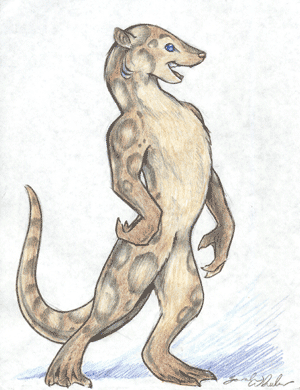 The
S'ree are the native sentient race of Clamp (1317 Foreven), but as such have
yet to even be discovered, after some 1000 years of sporadic visitation, and
even after a long period of relatively heavy colonization.
The
S'ree are the native sentient race of Clamp (1317 Foreven), but as such have
yet to even be discovered, after some 1000 years of sporadic visitation, and
even after a long period of relatively heavy colonization. | The S'ree |
(Art this page by Sarah Wheeler)
 The
S'ree are the native sentient race of Clamp (1317 Foreven), but as such have
yet to even be discovered, after some 1000 years of sporadic visitation, and
even after a long period of relatively heavy colonization.
The
S'ree are the native sentient race of Clamp (1317 Foreven), but as such have
yet to even be discovered, after some 1000 years of sporadic visitation, and
even after a long period of relatively heavy colonization.
Physiology
Physically, initially they appear as giant river otters, coated with light tan fur that gives way to clouded blue, aqua, white and black leopard patterns along their sides and backs. Their meter long tails taper to long thin points. They have gills, though they're vestigial, allowing for extended diving up the standard age of six years, and thereafter losing all function. Their hands and feet are stubby, and webbed, though the webbing on their fingers has atrophied somewhat with their evolution onto land. Ears are small, circular, streamlined extensions of skin, that can 'fold under' when irritated by loud noise or when swimming. S'ree stand roughly 5' tall (1.6 meters), with males averaging slightly larger than females.
S'ree have nictating eyelids that provide excellent vision and protection even in murky water. Their color sight is somewhat limited compared to humans, though it excels in dusk or low light environments, and is especially sensitive to movement. S'ree sense of smell is fairly acute, though not that much more fine tuned than a human's, while their sense of taste is much more advanced. S'ree have two sexes, and give birth to a single egg after a gestation period of about a month. Eggs are kept in a warm nursery chamber, and incubate for about two months before hatching, and the newborn kit being welcomed into the family.
History
S'ree history is very difficult to piece together, in part thanks to their all
encompassing sense of the past. Anything that happened more than a few days
ago can be lumped into a general category of 'yesterday' by the S'ree, who see
no need to distinguish between ten and a thousand years ago. S'ree began to
develop language well after they developed tool use, with the advent of cooperative
hunting parties forming along the banks of Geevu. Some 500,000 years ago, a
meteorite smashed into the headwaters of their primary river, causing the extinction
of several of the fish and lizards the S'ree lived on. Foraging and hunting
parties drifted out from the riverbanks, and eventually cooperation led to language
for coordination over long distances, and later written language was developed
to demark territorial boundaries.
Culture
S'ree culture arose slowly with the advent of river trade between families.
Eventually a whole new form of family, called Kajeks, formed on the river, adopting
their new members from overcrowded bank families and trading news and specialty
crafts wherever they went. Those that wished to have children left the river
boats to live with a bank family, enabling a river based genetic distribution
system. The river families also helped establish an ongoing, homogenous culture,
though accents and family traits varied highly along its 2000 mile river course.
About 50,000 years ago the S'ree plateau'd at about tech level 2, and though bursts of insight occasionally surfaced, any changes, without a concerted effort of the entire populace, and without advanced industrialization techniques, or a cohesive leadership, were short lived. Even at TL 2, most S'ree don't abandon earlier technologies when seen as practical, or just interesting or traditional.
Psychology
S'ree are intelligent, curious, and prone to thinking in the immediate sense,
caring only vaguely about long term consequences, though short term goals are
easily understood. Their sense of the past is spotty, and the idea of 'history'
is confusing to a S'ree, who sees no real sense of shame or pride in his or
her distant past, though they do remember it and learn from their mistakes.
Accomplishment for a S'ree is only evidenced by what is present now, what can
be claimed in the immediate future. They honor their dead, mourning for a local
year, after which the name of the deceased is 'forgotten', unless given to a
newly hatched relative.
Traditions do exist, though they tend only to last as long as 'ghosts', what they call the 2 meter tall carved stones dotting their territory, remain standing. Each 'ghost' is a written record which recounts the major events that shaped the family that keeps it and list mistakes made and triumphs accomplished. The writings aren't revered however, but seen as handy 'how-to' books from the past, remembering what's useful so that it may be applied again in the future. Every few years bank erosion or other disaster will drop a 'ghost' into the river, after which point the memories of those traditions are allowed to fade and a new stone drawn up if necessary.